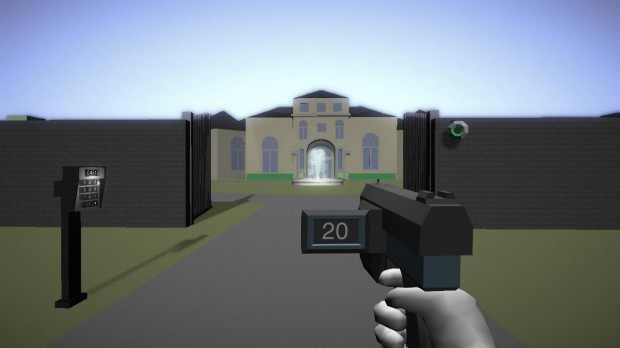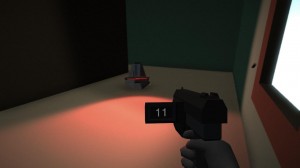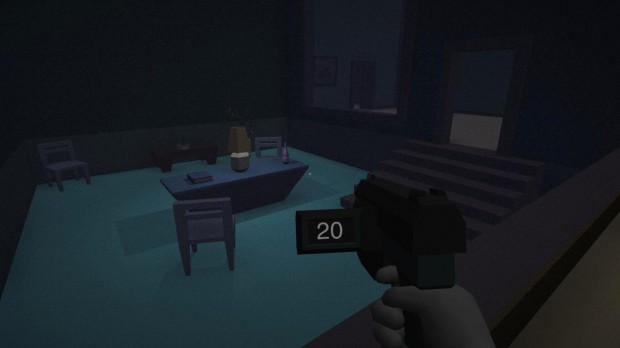Indie Rock: The King Of The Wood
- Updated: 27th Feb, 2013

The most popular games in the world are massive scale military shooters with no real plot to speak of, set from a first-person perspective. It’s a tough complaint to have, because it feels petty even trying to address it here, but it’s terrible that a vast audience will probably see a first-person game when you shoot things as synonymous with a lack of complexity in narrative or thematics.
I played The King Of The Wood this week. It was a first person game where you shoot things, it actually had a thought-provoking but simple plot which was helped by the player’s involvement and it made for a nice change.
Gravity Bone’s a bit older. It’s the breakout hit for BLENDO games. It’s something you’ve probably played so you don’t need me to go over it and if you haven’t you definitely don’t want anything spoiled. I’ll say that Gravity Bone is a rare instance of a game that misleads you through mechanics, holds a lot of information back about your role in the world and even though it comes to a fitting narrative conclusion, it’s still open to a lot of interpretation. That’s the same for the pseudo-sequel 30 Flights Of Loving, too, which is in many ways an improvement over these core principles.
The King Of The Wood isn’t as good as Gravity Bone. I say that as a compliment, because although a great many things aren’t as good as Gravity Bone, The King Of The Wood at least does enough for you to be able to make direct comparisons. You can see the influence right off the bat. There’s the same level of sparseness in design, interest in having all music come from a diegetic source and have the focus heavily on ambiguity. TKOTW doesn’t, however, attempt to hide gamic instructions within an in-word context and immediately does more to have the player better understand their role in the world. These two things misunderstand Gravity Bone’s unique qualities: heavily providing a sense of emergence and not letting a lack of player understanding get in the way of their ability to progress.
The King Of The Wood suffers a little from the environments feeling empty. The sparseness is key to the feeling of weird isolation, but a lot of the ground floor feels large just because there needed to be space upstairs for more rooms. It tips off that this game was produced somewhat quickly. It’s not a massive problem, but when you’re emulating a game that has had such a clear iteration and polish, it doesn’t help.
What I like most about the game doesn’t come into play until the last room, and it’s too good to talk about outright, so heres where this stops being a recommendation and says You Should Play The King Of The Wood Right Now And Come Back So We Can Talk About What Happens.
Right. Okay.
So in the final room, the place you’ve died and respawned over and over again to get to, there’s no climactic fight. There’s just someone resigned to their fate and doing something they love in their final moments. There’s no way to get them to engage with you other than shooting them. That’s what you came there to do, so you do it.
I’ve never seen a game do this before.
You shoot them. The music stops. You’re still playing. There’s no “Game Over” screen yet, you’ve just shot someone in cold blood and that’s it (until you figure out what happens next). It reminds me of having to walk back through Hotline Miami levels; not thinking about what you’re doing at the time and yet being forced to recognise what you’ve done afterwards.
 My reading of this, which is probably giving the developer too much credit, is this is a commentary on the sanctity of artificial life and it’s done through you playing the game. You’ve been fighting robots the entire time that basically amount to roombas with lasers attached; shooting them doesn’t register as important. It’s when you have to finally fire on something that’s essentially human that and doesn’t do anything aggressive that you suddenly have a problem.
My reading of this, which is probably giving the developer too much credit, is this is a commentary on the sanctity of artificial life and it’s done through you playing the game. You’ve been fighting robots the entire time that basically amount to roombas with lasers attached; shooting them doesn’t register as important. It’s when you have to finally fire on something that’s essentially human that and doesn’t do anything aggressive that you suddenly have a problem.
The roombas are barely autonomous and they engage you in a situation where you have to kill them to progress. The actual target is sentient, but still as much a machine, yet it’s more meaningful when they’re forcefully deactivated.
That’s really something. That’s gameplay helping create a sensation you wouldn’t have had if you’d just watched the scene happen. Having to pull the trigger, being able to walk around the room waiting to see if some scripting will come into effect and the guy will start trying to fight for his life, that’s a hesitation that you have to get over yourself.
That’s why it’s awful that we assume first-person shooters are mindless and unnecessary. Occasionally you get a nice surprise.


Follow Us!